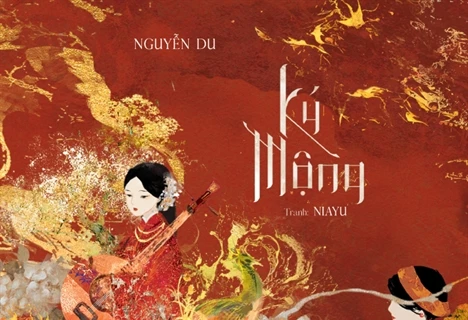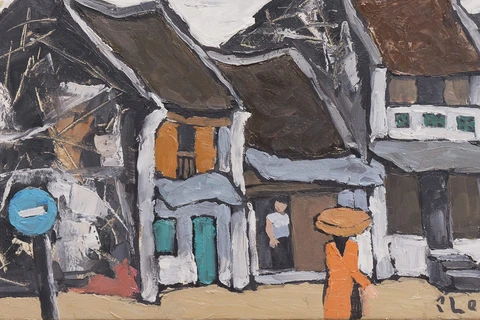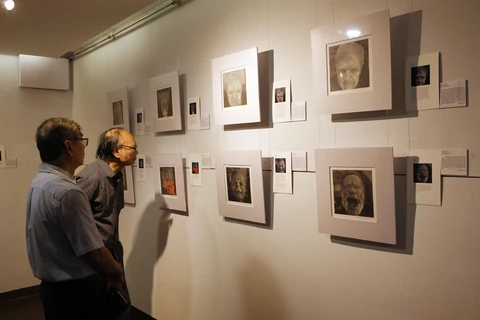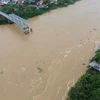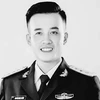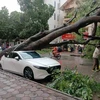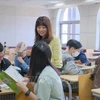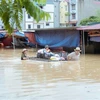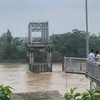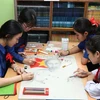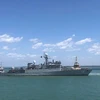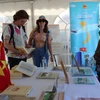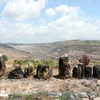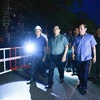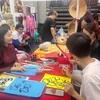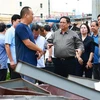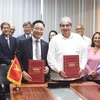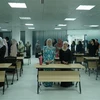Hanoi (VNA) – David Thomas, an American painter and a war veteran, has visited Vietnam many time, seeking to heal himself from pains in the past and used art to oppose the war.
His latest works are being showcased at the Vietnam Fine Arts Museum at Nguyen Thai Hoc street in Hanoi.
The artist, who fought in the war in the Central Highlands of Vietnam in 1969, told VietnamPlus about his stories and his love for Vietnam.
Reporter: You said you first came to Vietnam during the war. How do you feel when recalling those days?
David Thomas: In June 1968, after graduating from Portland Art School, I joined the army. From April 11, 1969 to March 22, 1970, I was stationed in Pleiku, Buon Me Thuot, Kon Tum, South Vietnam. My job was to drive a jeep to transport goods and draw maps.
What I remember the most was the Central Highlands children who surrounded my jeep and played with my radio whenever I stopped. At that time, I was very happy to play with them. In the group, I was especially close to a girl who was deaf and dumb. There was no language barrier at all, we "spoke" with our hands.
At that time, for me it was simple that I just went on a mission. Later, the more I thought about it, the more I felt sorry and tormented for the children who grew up in a bad situation. When I returned to America, what I remembered most was the smiles of the children.
When people talk about Vietnam, they think of the war, but I discovered other beauties of the country and its people, the beautiful souls full of poetry and desire for peace, and the resilience to overcome all the difficulties of war.
I did not participate in anti-war protests in the streets. Instead, I painted many pictures of Vietnamese children, reflecting the devastation the Americans have caused in that country.
Reporter: What did you think when you heard about the reunification of Vietnam on April 30, 1975?
David Thomas: I'm glad the war is over. The Vietnamese people now have the peace they deserve after centuries of struggle against invasions by many countries. I think of the children in the Central Highlands forest, they will be able to go to school and live a normal life.
The war is over, but the reality is that its consequences linger. The legacy of Agent Orange that I suffer from is one example. Millions of Vietnamese are also victims of this deadly weapon. This generation may be healthy, but will their descendants carry the consequences? Unexploded ordnance is still in the ground, which can cause accidents and injuries to people.
So, in some way, the shadow of the war is still there. That's why I'm still creating, to tell people about it.
Reporter: What brought you back to Vietnam in 1987 and in later years?
David Thomas: It was simply a personal effort of going back to the country where I was involved in the war in my youth, to find a way to connect and mend the past.
Little did I know that I would spend the rest of my life trying to ease the pain caused by the American war there, to educate Americans here about the real tragedy of our invasion of Vietnam.
I have been invited into the homes of our “former enemy” many times only to learn how much we have in common. We have laughed and cried together and shared many beautiful memories and hopes for the future.
A year later, in the summer of 1988, I founded the non-profit Indochina Arts Association (IAP) to create a bridge between the two countries' culture, art, and people-to-people diplomacy. I want Americans and the world to know that Vietnam is a wonderful country, with great people. As at that time, people only knew about Vietnam with the keyword of “war”.
Reporter: It's a pity that after more than 30 years of active work, IAP has had to stop operation.
David Thomas: Yes, IAP has connected many Vietnamese and American artists, organised many exhibitions showing the artistic perspectives of artists from both countries, and also brought dozens of Vietnamese artists to the US for exhibition, exchange, and study. Since then, I have had close friends such as painter Le Huy Tiep, painter Phan Cam Thuong... But this is a non-profit organisation that needs to raise funds to operate. In 2019, I was old and had Parkinson's, so I decided to stop running IAP.
Reporter: How has this disease caused difficulties for you in doing artistic works?
David Thomas: In 2015, I was diagnosed with Parkinson's disease, possibly caused by exposure to Agent Orange/dioxin during the war.
During the one year I was stationed in the Central Highlands, my unit was also responsible for killing the vegetation a hundred yards on either side of the roads we were building and at all work sites. This was done primarily to remove jungle growth where snipers and enemy soldiers could hide.
Although I was assured by my superiors that this poison only kills plants and is harmless to humans, I always doubted it.
On December 14, 2020, I saw my brain for the first time after an MRI scan. So I decided to use these images to create graphic works about the consequences of war. So, will this illness hinder me or become a mean for me to continue to be creative? Time will tell.
Reporter: Many Vietnamese artists who came to the US under the IAP programme visited your house and said that there is a unique cyclo in Boston?
David Thomas: That's right. I have been to Vietnam many times over the decades. In the ‘90s, cyclo was very popular, especially in the Old Quarter and around Metropole hotel. I usually looked for a familiar cyclo driver every time I came here. His name was Bang.
Around 1995, Bang suffered from back pain so he wanted to retire. At the same time, he was planning a wedding for his daughter and wanted to sell the cyclo for money. I bought it back for 100 USD. At that time, 100 USD wasn't much for Americans, but it was enough to cover a decent wedding in Vietnam. We were both very happy about the deal.
However, transporting the cyclo to my home in Boston was not an easy. I had to ask for help from friends in Vietnam. They unassembled the cyclo, sent it to Laos, Cambodia and then to the US by sea.
I repainted it, changed its tires and roof. So far, it's been running fine. In the past, I used to take my grandchildren on this cyclo around the house. I really like this cyclo because it's a part of Hanoi, very different from cyclo in Hue or Ho Chi Minh City.
Reporter: Thank you for your time./.


